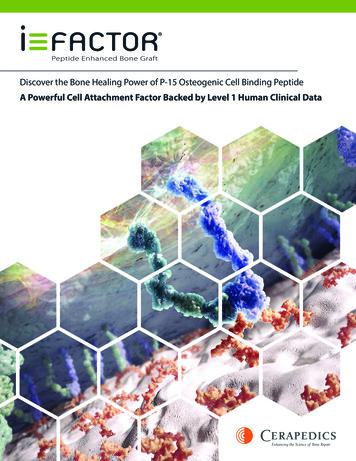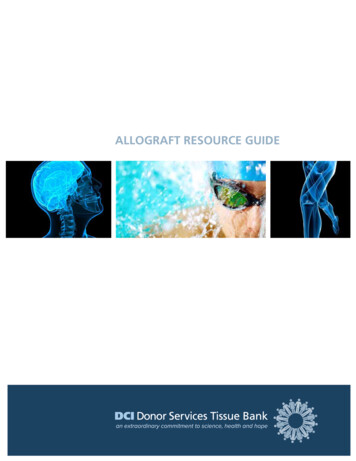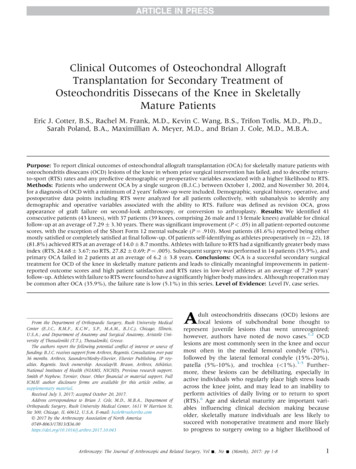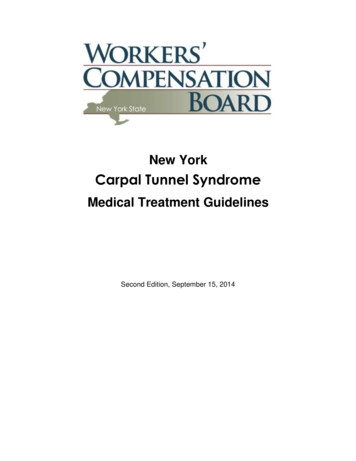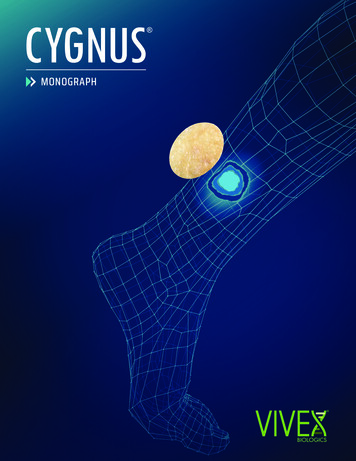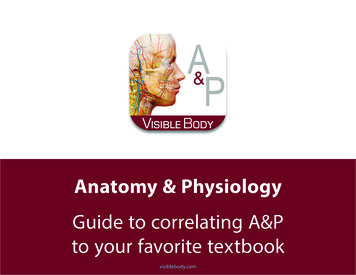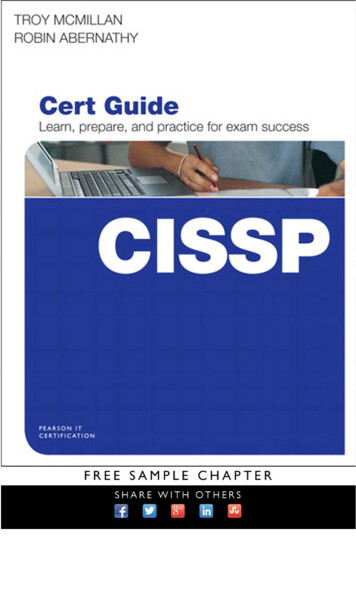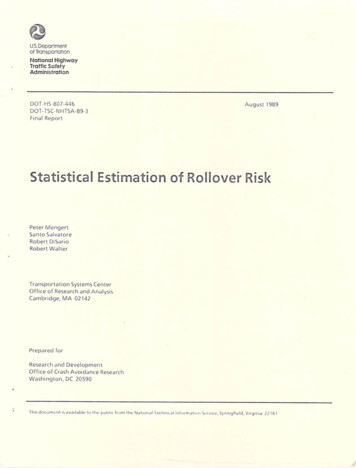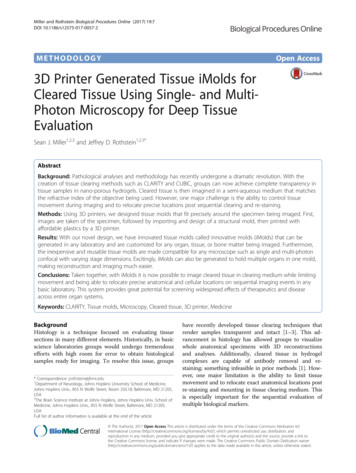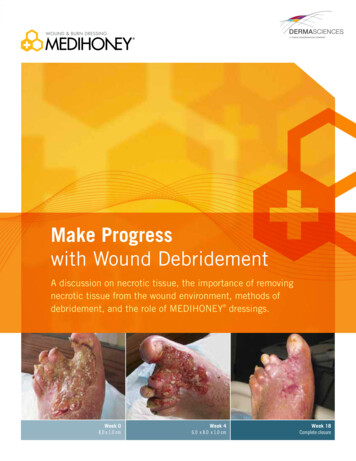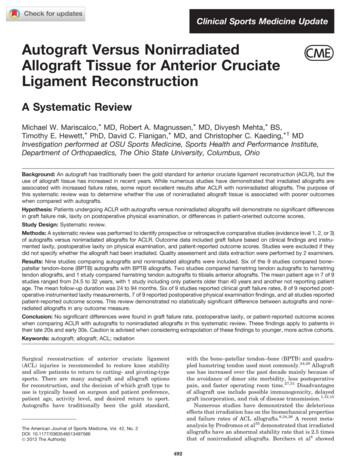
Transcription
Clinical Sports Medicine UpdateAutograft Versus NonirradiatedAllograft Tissue for Anterior CruciateLigament ReconstructionMA Systematic ReviewMichael W. Mariscalco,* MD, Robert A. Magnussen,* MD, Divyesh Mehta,* BS,Timothy E. Hewett,* PhD, David C. Flanigan,* MD, and Christopher C. Kaeding,*y MDInvestigation performed at OSU Sports Medicine, Sports Health and Performance Institute,Department of Orthopaedics, The Ohio State University, Columbus, OhioBackground: An autograft has traditionally been the gold standard for anterior cruciate ligament reconstruction (ACLR), but theuse of allograft tissue has increased in recent years. While numerous studies have demonstrated that irradiated allografts areassociated with increased failure rates, some report excellent results after ACLR with nonirradiated allografts. The purpose ofthis systematic review was to determine whether the use of nonirradiated allograft tissue is associated with poorer outcomeswhen compared with autografts.Hypothesis: Patients undergoing ACLR with autografts versus nonirradiated allografts will demonstrate no significant differencesin graft failure risk, laxity on postoperative physical examination, or differences in patient-oriented outcome scores.Study Design: Systematic review.Methods: A systematic review was performed to identify prospective or retrospective comparative studies (evidence level 1, 2, or 3)of autografts versus nonirradiated allografts for ACLR. Outcome data included graft failure based on clinical findings and instrumented laxity, postoperative laxity on physical examination, and patient-reported outcome scores. Studies were excluded if theydid not specify whether the allograft had been irradiated. Quality assessment and data extraction were performed by 2 examiners.Results: Nine studies comparing autografts and nonirradiated allografts were included. Six of the 9 studies compared bone–patellar tendon–bone (BPTB) autografts with BPTB allografts. Two studies compared hamstring tendon autografts to hamstringtendon allografts, and 1 study compared hamstring tendon autografts to tibialis anterior allografts. The mean patient age in 7 of 9studies ranged from 24.5 to 32 years, with 1 study including only patients older than 40 years and another not reporting patientage. The mean follow-up duration was 24 to 94 months. Six of 9 studies reported clinical graft failure rates, 8 of 9 reported postoperative instrumented laxity measurements, 7 of 9 reported postoperative physical examination findings, and all studies reportedpatient-reported outcome scores. This review demonstrated no statistically significant difference between autografts and nonirradiated allografts in any outcome measure.Conclusion: No significant differences were found in graft failure rate, postoperative laxity, or patient-reported outcome scoreswhen comparing ACLR with autografts to nonirradiated allografts in this systematic review. These findings apply to patients intheir late 20s and early 30s. Caution is advised when considering extrapolation of these findings to younger, more active cohorts.Keywords: autograft; allograft; ACL; radiationwith the bone–patellar tendon–bone (BPTB) and quadrupled hamstring tendon used most commonly.24,28 Allograftuse has increased over the past decade mainly because ofthe avoidance of donor site morbidity, less postoperativepain, and faster operating room time.27,31 Disadvantagesof allograft use include possible immunogenicity, delayedgraft incorporation, and risk of disease transmission.1,12,15Numerous studies have demonstrated the deleteriouseffects that irradiation has on the biomechanical propertiesand failure rates of ACL allografts.8,34,36 A recent metaanalysis by Prodromos et al33 demonstrated that irradiatedallografts have an abnormal stability rate that is 2.5 timesthat of nonirradiated allografts. Borchers et al4 showedSurgical reconstruction of anterior cruciate ligament(ACL) injuries is recommended to restore knee stabilityand allow patients to return to cutting- and pivoting-typesports. There are many autograft and allograft optionsfor reconstruction, and the decision of which graft type touse is typically based on surgeon and patient preference,patient age, activity level, and desired return to sport.Autografts have traditionally been the gold standard,The American Journal of Sports Medicine, Vol. 42, No. 2DOI: 10.1177/0363546513497566Ó 2013 The Author(s)492
Vol. 42, No. 2, 2014Autograft vs Nonirradiated Allograft for ACLR493that the odds of failure after ACL reconstruction with anirradiated allograft were 5.6 times those after reconstruction with an autograft.Three previous systematic reviews have compared theoutcomes of ACL reconstruction using autografts versusallografts.5,10,18 These systematic reviews have varied interms of their level of evidence, included graft types, andoutcomes of interest. A common limitation of each review,however, is the inclusion of irradiated grafts in the allograft group. The purpose of the current systematic reviewwas to determine whether the use of nonirradiated allograft tissue is associated with increased graft failure rates,postoperative laxity on physical examination, and/orpoorer patient-reported outcome scores. We hypothesizedthat ACL reconstruction with nonirradiated allograft tissue was not associated with (1) an increased odds of graftfailure as determined clinically or through instrumentedlaxity testing, (2) increased laxity on postoperative physical examination, or (3) decreased patient-reported outcomescores relative to ACL reconstruction with autograft tissue.MATERIALS AND METHODSEligibility CriteriaAll English-language prospective or retrospective comparative studies (evidence level 1, 2, or 3) comparing outcomes ofprimary ACL reconstruction with autograft tissue versusnonirradiated allograft tissue were eligible for inclusion inthis review. Studies were excluded if it was not clearlystated whether the allograft had been irradiated. Patientsof all ages were included. Each study was required tohave a minimum of 15 patients in each group and a meanfollow-up of at least 2 years. Outcome data including clinicalor instrumented failure rates or patient-reported outcomescores were required for inclusion.Literature Search and Study SelectionLiterature review included a search of Scopus, Embase,CINAHL, and Cochrane Collaboration systematic reviewsthrough October 12, 2012. Two independent reviewers(M.W.M. and D.M.) separately completed the search. Searchterms included ‘‘autograft,’’ ‘‘allograft,’’ and ‘‘anterior cruciate ligament.’’ This search yielded a total of 649 studiesacross all databases. After applying a filter to include onlyhuman, English-language, and comparative autograft andallograft studies, 114 studies remained. The title andabstract of all 114 studies were reviewed, and 36 duplicatestudies were removed. Of the 78 remaining studies, 57were excluded for the following reasons: study unrelatedto the research question (n 24), studies not published inthe English language (n 8), cost-effectiveness analysesFigure 1. Flowchart describing the literature search andstudy selection.(n 6), studies comparing 2 types of allograft (n 5), reviewpapers with no original data (n 4), animal studies (n 4),papers focused on infection rates (n 2), short follow-up (n 2), 1 opinion/survey paper, and 1 paper utilizing nonstandard graft processing. This left a total of 21 comparativestudies. Twelve of the 21 studies were excluded for not specifying whether the allografts had been irradiated (n 6)2,21,22,25,29,33 or including allografts that had been irradiated (n 6).6,11,26,36,37,39 The 9 remaining studies comparedautograft and nonirradiated allograft tissue.z The referencesection of each included study was reviewed to ensure thatno studies were missed in the literature review. The literature search is summarized in Figure 1.Data ExtractionTwo authors (M.W.M. and D.M.) independently extractedall relevant data. These data included the study’s countryzReferences 3, 9, 13, 17, 19, 20, 32, 38, 40.yAddress correspondence to Christopher C. Kaeding, MD, OSU Sports Medicine, Sports Health and Performance Institute, Department of Orthopaedics, The Ohio State University, 2050 Kenny Road, Suite 3300, Columbus, OH 43221 (e-mail: Christopher.Kaeding@osumc.edu).*OSU Sports Medicine, Sports Health and Performance Institute, Department of Orthopaedics, The Ohio State University, Columbus, Ohio.One or more of the authors has declared the following potential conflict of interest or source of funding: Research reported in this publication was supported by the National Institute of Arthritis and Musculoskeletal and Skin Diseases of the National Institutes of Health (award number K23AR063767). Thecontent is solely the responsibility of the authors and does not necessarily represent the official views of the National Institutes of Health.
494Mariscalco et alThe American Journal of Sports MedicineTABLE 1Study DescriptionaAuthorSun et al40Lawhorn et al20Sun et al38Edgar et al9Barrett et al3Peterson et al32Kleipool et al17Harner et al13Kustos et al19JournalYearCountryProcedure Date RangeDetermination of TreatmentLevel of opyKSSTACORRInt ent choice 25%, randomized 75%Patient choicePatient choiceAllograft availabilityPatient choice and allograft availabilityPatient choice222232233aAJSM, American Journal of Sports Medicine; CORR, Clinical Orthopaedics and Related Research; Int Orthop, International Orthopaedics; KSSTA, Knee Surgery Sports Traumatology and Arthroscopy.of origin, procedure date range, number of surgeons, number of eligible patients, percentage of eligible patients withfollow-up, mean follow-up time, study design, patientdemographics, whether the injury involved a sports mechanism, time from injury to reconstruction, graft choice,surgical technique and graft fixation, physical examinationfindings, the use of independent and/or blinded examiners,clinical failure rates, instrumented laxity measurements(KT-1000 or KT-2000 arthrometer), and patient-reportedoutcome scores.cases of qualitative homogeneity, statistical testing of homogeneity (x2) was performed. If the observed variation wasinconsistent with the null hypothesis (P \ .1), no meta-analysis was performed. In cases in which data were qualitativelyheterogeneous, no statistical analysis of heterogeneity wasperformed. For outcome variables sufficiently homogeneousfor meta-analysis, a Mantel-Haenszel analysis utilizing a random-effects model was used to pool results according to grafttissue (allograft vs autograft) while accounting for the number of patients in individual studies.35Methodological Quality AssessmentRESULTSTwo authors (M.W.M. and D.M.) separately graded the methodological quality of each eligible study using the Delphi listquality score and modified Coleman methodology score. TheDelphi scoring system was based on 9 questions: Wasa method of randomization used? Was the treatment allocation concealed? Were the groups similar at baseline? Wereeligibility criteria specified? Was the outcome assessorblinded? Was the care provider blinded? Was the patientblinded? Were point estimates and measures of variabilityused? Was there an intention-to-treat analysis? Each question was given 1 point for ‘‘yes,’’ 1 point was deducted for‘‘no,’’ and 0 points were given for ‘‘don’t know.’’42 The modifiedColeman score included questions on study size, mean followup, percentage of patients with follow-up, number of interventions per group, study type, diagnostic certainty of ACLtear, description of ACL reconstruction procedure, description of postoperative rehabilitation, specifications of outcomecriteria, procedures for assessing outcomes, and descriptionof patient selection process.7,23 The modified Coleman methodology score was based on a scaled maximum of 100 points.The study’s rating was considered excellent if the score was85 to 100 points, good if it was 70 to 84 points, fair if it was55 to 69 points, and poor if it was 54 points.Study Characteristics and OutcomesOf the 9 included studies, 6 studies were level29,17,20,32,38,40 and 3 studies were level 3.3,13,19 Of the 6level 2 studies, 3 were randomized controlled trials20,38,40(Table 1). Six of the 9 studies compared BPTB autograftsand BPTB allografts. Two studies compared quadrupledhamstring tendon autografts and quadrupled hamstringtendon allografts, and 1 study compared quadrupled hamstring tendon autografts and anterior tibialis allografts(Table 2). The number of patients with follow-up rangedfrom 60 to 186. The mean follow-up duration ranged from24 to 94 months. The mean patient age in 7 of 9 studiesranged from 24.5 to 32 years; 1 study reported a patientage of 40 to 54 years with no actual average, and anotherstudy did not report patient age (Table 3).Clinical failure risk was reported in 6 of 9 studies, whileinstrumented laxity measurements were reported in 8 of 9studies. Lachman test results were reported in 5 of 9 studies, and pivot-shift test results were reported in 7 of 9 studies. Patient-reported outcome scores were reported in all 9studies and included the Lysholm, Cincinnati, International Knee Documentation Committee (IKDC) subjective,and Tegner activity scores.14,30,41Statistical AnalysisEach outcome measure (graft failure as determined clinicallyor via instrumented laxity as well as patient-reported outcome scores) was qualitatively assessed for homogeneity. InStudy Methodological QualityThe Delphi list quality scores and the modified Colemanmethodology scores were calculated for all 9 studies (see
Vol. 42, No. 2, 2014Autograft vs Nonirradiated Allograft for ACLR495TABLE 2Surgical DetailsaAuthor (Year)No. of SurgeonsAutograft/Allograft TypeApproachFemoral FixationSun et al40 orn et al20 (2012)5Hamstring/tibialis anteriorEndoscopicCross pinsSun et al38 (2009)Edgar et al9 scopicInterference screwEndobutton plusinterference screwBarrett et al3 (2005)1BPTB/BPTBEndoscopicInterference screwor BEndoscopicEndoscopic2 incisionEndoscopicInterference screwInterference screwNRInterference screwPeterson et al32 (2001)Kleipool et al17 (1998)Harner et al13 (1996)Kustos et al19 (2004)Tibial FixationInterference screwplus stapleSpiked washer andcompression screwInterference screwInterference screwplus spiked washerand screwInterference screw/post, Endobutton/post, stapleInterference screwInterference screwNRInterference screwaBPTB, bone–patellar tendon–bone; NR, not reported.TABLE 3Study Demographics and Follow-upaAutograft GroupAllograft GroupAuthor (Year)Age, Mean(Range), ySex,M:F, nFollow-up,Mean (Range), moFollowup,b %Age, Mean(Range), ySex,M:F, nFollow-up,Mean (Range), moFollowup,b %Sun et al40 (2011)Lawhorn et al20 (2012)Sun et al38 (2009)Edgar et al9 (2008)Barrett et al3 (2005)Peterson et al32 (2001)Kleipool et al17 (1998)Harner et al13 (1996)Kustos et al19 (2004)30 (19-56)32 (16-53)32 (20-54)27(40-54)25 (15-43)28 522:491 (72-120)2467 (48-95)52 (38-70)48 (24-99)65 (57-78)52 (42-74)45 (30-75)38 (12-72)88 (91/104)728881 overall (37/NR)100 (25/25)42 (30/71)90 (26/29)32 (26/82)100 (26/26)31 (18-59)33 (16-53)33 (19-65)31(40-58)28 (15-55)28 :1338:1495 (72-120)2467 (50-96)48 (36-64)36 (24-74)63 (55-73)46 (30-64)45 (30-75)38 (12-72)91 (95/104)679381 overall (46/NR)100 (38/38)63 (30/48)92 (36/39)40 (64/162)100 (53/53)abNR, not reported.Numbers (n) of total are in parentheses.the Appendix, available in the online version of this articleat http://ajsm.sagepub.com/supplemental). Based on thescaled maximum of 100 points, the mean overall modifiedColeman score for the 9 studies was 67. Two studies werecategorized as excellent, 1 study was categorized as good,4 studies were categorized as fair, and 2 studies were categorized as poor.5 mm greater than the contralateral side. According to thisdefinition of failure, the overall failure risk across the 8 studies was 6.0% (22/364) in the autograft group and 5.5% (24/437) in the allograft group. Meta-analysis indicated noincreased risk of graft failure in the allograft group (Figure 3).Laxity on Physical ExaminationFailure RiskClinical failure risk (as defined by the authors) was compared between autografts and allografts in 6 studies.According to this definition of failure, the overall failurerisk across the 6 studies was 3.0% (6/198) in the autograftgroup and 2.4% (6/251) in the allograft group. Metaanalysis indicated no increased risk of graft failure in theallograft group (Figure 2).Failure risk as determined by instrumented laxity measurements was compared between autografts and allograftsin 8 studies. Failure was defined as anterior laxity of at leastAnterior laxity as assessed with the Lachman examinationwas reported in 5 studies. No study noted a statisticallysignificant difference between the autograft and allograftgroups (Table 4). Meta-analysis indicated no difference inthe risk of having a Lachman grade greater than 0 betweenthe 2 treatment groups (Figure 4).Rotational laxity as assessed with the pivot-shift examination was reported in 5 studies. No study noted a statistically significant difference between the autograft andallograft groups (Table 5). Meta-analysis indicated no difference in the risk of having a pivot shift greater than0 between the 2 treatment groups (Figure 5). The Harner
496Mariscalco et alThe American Journal of Sports MedicineFigure 2. Forest plot of clinical failure risk for autografts versus allografts. The pooled odds ratio with 95% confidence intervalshas been calculated with a Mantel-Haenszel (M-H) analysis utilizing a random-effects model.Figure 3. Forest plot of instrumented laxity failure risk for autografts versus allografts. The pooled odds ratio with 95% confidence intervals has been calculated with a Mantel-Haenszel analysis (M-H) utilizing a random-effects model.Figure 4. Forest plot of the risk of a Lachman grade greater than 0 for autografts versus allografts. The pooled odds ratio with95% confidence intervals has been calculated with a Mantel-Haenszel (M-H) analysis utilizing a random-effects model.et al13 study did not differentiate between a pivot shift of0 and 1 and was not included in the meta-analysis.Patient-Reported Outcome ScoresPatient-reported outcome scores were reported in everystudy. All studies used the Lysholm or subjectiveIKDC score. Five studies used both scoring systems.The Cincinnati knee score was also used in 3 of the9 studies. The Tegner activity score was reported in6 studies. There was no statistically significant difference between autograft and allograft reconstructionsin any patient-reported outcome score in any study(Table 6).
Vol. 42, No. 2, 2014Autograft vs Nonirradiated Allograft for ACLR497TABLE 4Postoperative Lachman Results (in Percentages)aLachman GradeAutograftAuthor (Year)Sun et al40 (2011)Sun et al38 (2009)Barrett et al3 (2005)Peterson et al32 (2001)Kleipool et al17 2307.7 (7/91)7 (5/76)0 (0/25)3 (1/30)15 (4/26)0 (0/91)0 (0/76)Not usedNot used0 4(8/95)(6/80)(1/38)(3/30)(5/36)3P Value0 (0/95)0 (0/80)Not usedNot used0 (0/36)NSNSNSNSNSaNumbers (n) of total are in parentheses. NS, not significant.Figure 5. Forest plot of the risk of a pivot shift greater than 0 for autografts versus allografts. The pooled odds ratio with 95%confidence intervals has been calculated with a Mantel-Haenszel (M-H) analysis utilizing a random-effects model.TABLE 5Postoperative Pivot-Shift Results (in Percentages)aPivot-Shift GradeAutograftAuthor (Year)Sun et al40 (2011)Lawhorn et al20 (2012)Sun et al38 (2009)Barrett et al3 (2005)Peterson et al32 (2001)Kleipool et al17 (1998)Harner et al13 (1996)Allograft0123092 (84/91)89 (48/54)93 (71/76)100 (25/25)90 (27/30)73 (19/26)92 (24/26)8 (7/91)9 (5/54)7 (5/76)0 (0/25)7 (2/30)23 (6/26)0 (0/91)0 (0/54)0 (0/76)0 (0/25)3 (1/30)4 (1/26)8 (2/26)0 (0/91)2 (1/54)0 (0/76)Not usedNot used0 /38)(4/30)(5/36)23P Value0 (0/95)0 (0/48)0 (0/80)3 (1/38)3 (1/30)8 (3/36)11 (7/64)0 (0/95)0 (0/48)0 (0/80)Not usedNot used0 (0/36)NSNSNSNSNSNSNSaNumbers (n) of total are in parentheses. NS, not significant.DISCUSSIONThis systematic review is the first to compare outcomes ofACL reconstruction with autograft versus exclusively nonirradiated allograft tissue. This review demonstrates nostatistically significant difference between autografts andnonirradiated allografts with regard to failure risk, physical examination findings, or patient-reported outcomescores. It is critically important to note that the results ofthis study can only be applied to patient populations thatare similar to the patients included in the source studies.Mean patient age in the studies was generally in the late20s to early 30s, with 1 study focused on patients in their40s. It has also been shown that the risk of graft failuredecreases with increasing age.16 Therefore, the studies inthis systematic review did not evaluate allograft use inthe highest risk population for graft failure, and this factcould bias the findings. Application of the findings of thisstudy to a younger, more active population would not beappropriate.
498Mariscalco et alThe American Journal of Sports MedicineTABLE 6Postoperative Patient-Reported Outcome ScoresaPatient-Oriented Outcome ScoresAuthor (Year)40Sun et al (2011)Lawhorn et al20 (2012)Sun et al38 (2009)Edgar et al9 (2008)Barrett et al3 (2005)Peterson et al32 (2001)Kleipool et al17 (1998)Harner et al13 (1996)Kustos et al19 (2004)Tegner Activity ScoresFormAutograftAllograftP ValueAutograftAllograftP ValueLysholmCincinnatiIKDC subjectiveLysholmCincinnatiIKDC S6.86.9NS4.36.14.15.4NSNSaIKDC, International Knee Documentation Committee; NS, not significant.Literature review demonstrated only 1 study that stratified outcomes based on age and activity level. Barrett et al2showed at a minimum 2-year follow-up that patients youngerthan 25 years (mean age, 18 years) had significantlyincreased failure rates regardless of graft type. Reported failure rates for patients younger than 25 years were 12% forpatellar tendon autografts, 25% for hamstring tendon autografts, and 29% for allografts. In the allograft group, a combination of the patellar tendon and posterior tibialis were used,but it was not reported whether the allografts had been irradiated. In contrast, there was no statistically significant difference in failure rates among patients older than 25 years(mean age, 39 years) with different graft types.The results of the current review are similar to previously published meta-analyses and systematic reviewscomparing autograft and allograft usage in ACL reconstruction.5,10,18 The most recent review identified 31 prospective studies that included either autograft patientsalone (27 studies) or autograft and allograft groups (4 studies).10 After pooling the data, the authors could not findany statistically significant difference in laxity or IKDCscores between groups. Although graft failure rates werenoted to be 4.7 per 100 for autograft reconstructions and8.2 per 100 for allograft reconstructions, this trend didnot reach statistical significance. Carey et al5 included 9autograft versus allograft comparative studies. Three ofthe studies included irradiated allografts, while 1 did notreport whether irradiation was used. They showed no significant difference in Lysholm scores and instrumentedlaxity measurements between the groups. Clinical failurewas noted in 5 of 230 clinical failures in the autograftgroup and 11 of 240 in the allograft group, which was notstatistically significant. Krych et al18 performed a systematic review of 6 prospective nonrandomized cohort studiescomparing patellar tendon autografts and patellar tendonallografts. When irradiated and chemically processedallografts were excluded, there was no significant difference in IKDC scores, Lachman/pivot-shift testing, graftrupture, or rate of reoperation.Strengths of this study include the exclusive use of comparative studies and the inclusion of only studies thatutilized nonirradiated allografts. These relativelyhomogeneous data allowed for meta-analysis and resultedin clear evidence that nonirradiated allografts do not compromise the results of ACL reconstruction in the population analyzed. The key limitation of this study is theinability to comment on the effect or role of nonirradiatedallograft tissue in a younger, more active patient population. An additional limitation is that the majority of studiesincluded in the review utilized patellar tendon grafts. It isunknown whether results would differ if younger patientsand soft tissue grafts were more numerous in the dataset.CONCLUSIONThere were no significant differences in graft failure rate,postoperative laxity, or patient-reported outcome scoreswhen comparing ACL reconstruction with autografts tononirradiated allografts in this systematic review. Thesefindings apply to patients in their late 20s and early 30s.We caution against extrapolating these findings to younger, more active cohorts.An online CME course associated with this articleis available for 1 AMA PRA Category 1 CreditTM athttp://ajsm-cme.sagepub.com. In accordance with thestandards of the Accreditation Council for ContinuingMedical Education (ACCME), it is the policy of The American Orthopaedic Society for Sports Medicine thatauthors, editors, and planners disclose to the learnersall financial relationships during the past 12 monthswith any commercial interest (A ‘commercial interest’ isany entity producing, marketing, re-selling, or distributing health care goods or services consumed by, or usedon, patients). Any and all disclosures are provided inthe online journal CME area which is provided to all participants before they actually take the CME activity. Inaccordance with AOSSM policy, authors, editors, andplanners’ participation in this educational activity willbe predicated upon timely submission and review ofAOSSM disclosure. Noncompliance will result in anauthor/editor or planner to be stricken from participatingin this CME activity.
Vol. 42, No. 2, 2014REFERENCES1. Asselmeier MA, Caspari RB, Bottenfield S. A review of allograft processing and sterilization techniques and their role in transmission ofthe human immunodeficiency virus. Am J Sports Med. 1993;21(2):170-175.2. Barrett AM, Craft JA, Replogle WH, Hydrick JM, Barrett GR. Anteriorcruciate ligament graft failure: a comparison of graft type based onage and Tegner activity level. Am J Sports Med. 2011;39(10):2194-2198.3. Barrett G, Stokes D, White M. Anterior cruciate ligament reconstruction in patients older than 40 years: allograft versus autograft patellartendon. Am J Sports Med. 2005;33(10):1505-1512.4. Borchers JR, Pedroza A, Kaeding C. Activity level and graft type asrisk factors for anterior cruciate ligament graft failure: a case-controlstudy. Am J Sports Med. 2009;37(12):2362-2367.5. Carey JL, Dunn WR, Dahm DL, Zeger SL, Spindler KP. A systematicreview of anterior cruciate ligament reconstruction with autograft compared with allograft. J Bone Joint Surg Am. 2009;91(9):2242-2250.6. Chang SK, Egami DK, Shaieb MD, Kan DM, Richardson AB. Anteriorcruciate ligament reconstruction: allograft versus autograft. Arthroscopy. 2003;19(5):453-462.7. Cowan J, Lozano-Calderon S, Ring D. Quality of prospective controlledrandomized trials: analysis of trials of treatment for lateral epicondylitisas an example. J Bone Joint Surg Am. 2007;89(8):1693-1699.8. Curran AR, Adams DJ, Gill JL, Steiner ME, Scheller AD. The biomechanical effects of low-dose irradiation on bone-patellar tendonbone allografts. Am J Sports Med. 2004;32(5):1131-1135.9. Edgar CM, Zimmer S, Kakar S, Jones H, Schepsis AA. Prospectivecomparison of auto and allograft hamstring tendon constructs forACL reconstruction. Clin Orthop Relat Res. 2008;466(9):2238-2246.10. Foster TE, Wolfe BL, Ryan S, Silvestri L, Kaye EK. Does the graftsource really matter in the outcome of patients undergoing anteriorcruciate ligament reconstruction? An evaluation of autograft versusallograft reconstruction results: a systematic review. Am J SportsMed. 2010;38(1):189-199.11. Guo L, Yang L, Duan XJ, et al. Anterior cruciate ligament reconstruction with bone-patellar tendon-bone graft: comparison of autograft,fresh-frozen allograft, and gamma-irradiated allograft. Arthroscopy.2012;28(2):211-217.12. Harner CD, Fu FH. The immune response to allograft ACL reconstruction. Am J Knee Surg. 1993;6:45-46.13. Harner CD, Olson E, Irrgang JJ, Silverstein S, Fu FH, Silbey M. Allograft versus autograft anterior cruciate ligament reconstruction: 3- to5-year outcome. Clin Orthop Relat Res. 1996;324:134-144.14. Hefti F, Muller W, Jakob RP, Staubli HU. Evaluation of knee ligamentinjuries with the IKDC form. Knee Surg Sports Traumatol Arthrosc.1993;1(3-4):226-234.15. Jackson DW, Grood ES, Goldstein JD, et al. A comparison of patellartendon autograft and allograft used for anterior cruciate ligament reconstruction in the goat model. Am J Sports Med. 1993;21(2):176-185.16. Kaeding CC, Aros B, Pedroza A, et al. Allograft versus autograft anterior cruciate ligament reconstruction: predictors of failure froma MOON prospective l
yAddress correspondence to Christopher C. Kaeding, MD, OSU Sports Medicine, Sports Health and Performance Institute, Department of Orthopae-dics, The Ohio State University, 2050 Kenny Road, Suite 3300, Columbus, OH 43221 (e-mail: Christopher.Kaeding@osumc.edu).
